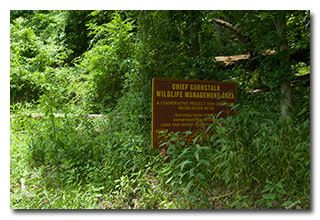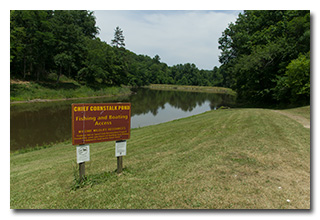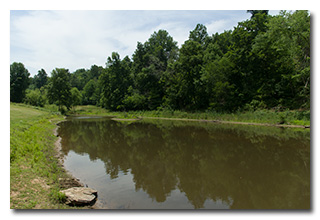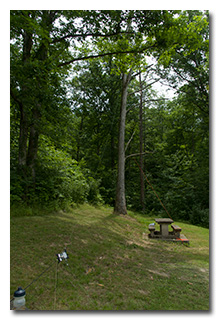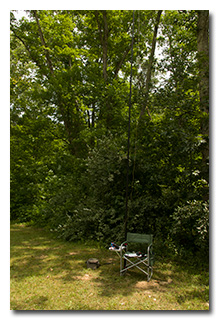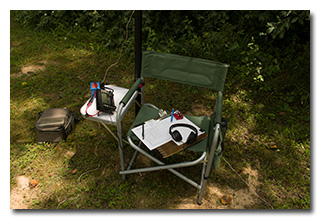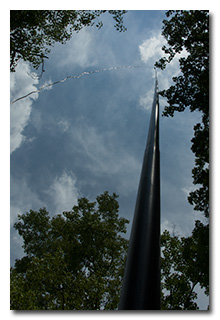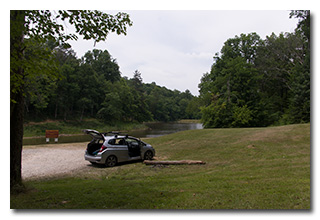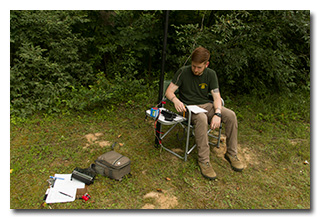
by William Eric McFadden
From the West Virginia Explorer entry:
-
The 11,772-acre Chief Cornstalk Wildlife Management Area (WMA) protects hardwood forests with gently rolling hills and moderately steep slopes in the upland between the Ohio and Kanawha rivers. Game traditionally taken in the management area includes deer, grouse, fox, mink, squirrel, turkey, muskrat, and raccoon. A five-acre lake accomodates fishing for trout, bluegill, largemouth bass, and channel catfish. The lake is stocked with trout from January to March. Fifteen primitive camping sites with vault toilets and a 200-yard shooting range have been developed.
Pictures
- The Chief Cornstalk WMA sign
- Chief Cornstalk Pond: 1| 2
- The Chameleon Emcomm III antenna
- The view from Eric's station
- Eric's station: 1 2
- Eric's mast
- Josh finishing his activation in the shade
Description
On Wednesday, June 19, 2024, one member of the Southeast Ohio Radio Adventure Team performed a successful activation of Chief Cornstalk Wildlife Management Area in West Virginia as part of the Parks on the Air (POTA; link) program.
Following successful activations of Tu-Endie-Wei State Park and Lewis and Clark National Historic Trail (link, Eric McFadden, WD8RIF, visited Chief Cornstalk Wildlife Management Area to perform the activation with Josh Senefeld, N8VXR (blog), a POTA activator who, prior to the activation of Tu-Endie-Wei State Park, hadn't performed a POTA activation in the state of West Virginia. Eric and Josh were accompanied by little black POTA-pup, Theo.
Realizing they hadn't beaten the heat, Eric, Josh, and Theo arrived at a very hot, and very humid, Chief Cornstalk Pond at about 1715 UTC. After a bit of exploring, they identified a shaded picnic table and a relatively flat shaded area against the woods. Eric and Josh began setting up Josh's station at the picnic table. Having elected to operate Eric's Elecraft KX2 at Tu-Endie-Wei State Park, Josh chose this time to try out Eric's Yaesu FT-817ND, and to try Eric's never-been-used Chameleon Emcomm III end-fed antenna (link. Having been convinced by Thomas Witherspoon, K4SWL, that throwing a line into a tree was an easy task—child's play, even—when one has real arborist's line and a propre throw-weight, Eric and Josh wasted about ten minutes taking turns, trying to throw Eric's arborist line over a relatively low branch on a dead tree, with no foliage or other branches in the way. Eventually, Josh was able to get the line over a broken branch—not the higher branch he had been aiming for, but a branch that would, they hoped, support the antenna. The tree wasn't far enough from the picnic table, and the branch wasn't high enough, to support the Emcomm III as a sloper, so Eric and Josh deployed the antenna as an inverted-vee. Placing Eric's FT-817ND on the shaded picnic table, and using Eric's LDG Z-11 automatic antenna tuner to match the antenna to the rig, Josh began studying the FT-817ND's manual and the FT-817 "Nifty Manual" to learn how to set up mic-gain, etc., before starting his activation.
For his station, Eric set up his folding camp-chair on the relatively flat shaded area, deploying his 28½' end-fed wire as a vertical supported on his 31' Jackite telescoping fiberglass mast bungied to the camp-chair, laying three 17' counterpoise wires directly on the ground, and placing his Elecraft KX3 on the camp-chair's pop-up table. Eric was on the air at 1740 UTC.
The solar A-Index was 10 and the K-Index was 2, indications that HF band conditions might be rough. This, in fact, turned out to be the case.
Josh had absolutely no cell-signal at this remote location, but Eric had just enough signal to to text his friends Mike, K8RAT, and Thomas, K4SWL for spotting-support.
With Josh choosing to start his operation on 17m, Eric began his operation on 20m and his first QSO came at 1742 UTC with K5FNQ in Louisiana. This was followed at 1734 UTC by a QSO with KG5OA in Texas, and at 1745 UTC by a QSO with K4MSW in Louisiana. Then, nothing...
Switching to 30m at 1752 UTC in hopes of finding better conditions there, Eric called CQ for fifteen minutes without hearing a single response.
Back on 20m, Eric's first QSO in this run came at 1808 UTC with VE3FI who, Eric learned later, was performing a two-fer activation of Great Lakes Waterfront Trail Recreation Site (CA-6003) and Parrott's Bay Conservation Area (CA-5142) in Ontario. This was followed over the next six minutes by QSOs with N4CD in Texas, KG8YT in Michigan, and KD2AE in New York. Then, 20m dried up again.
Switching to 40m, Eric's first QSO on this band came at 1820 UTC with W3RE in Pennsylvania. The 40m band proved to be much more productive than the 20m and 30m bands had been, with Eric's eighth QSO in this run coming at 1832 UTC with W0CGC in Tennessee. This run included what Eric learned later was a P2P QSO with VE3KZE who was activating The Great Trail of Canada National Scenic Trail (CA-5082) in Ontario and QSOs with operators located in Pennsylvania (2), New York, New Jersey, Ohio, Ontario, Michigan, and Tennessee.
With fifteen QSOs and a valid activation in the log, Eric paused to see how Josh was fairing. Josh, it turned out, had been having a terrible time. The sun had moved enough that what had initially been a nicely shaded picnic table was now a picnic table in direct sun. The Yaesu FT-817ND and the LDG Z-11 were, in Josh's words, "hot enough to fry an egg on"—which was a bit of an exageration, but not much of one—and the Z-11 kept trying to tune to the antenna every time Josh made a transmission. It was about an hour into his operation, and Josh had made only four QSOs. Hoping to salvage his activation, Josh chose to switch from the FT-817ND/Z-11 to Eric's Elecraft KX2 and, at Eric's suggestion, he moved down to Eric's still-in-the-shade camp-chair, hooked the KX2 up to Eric's antenna, and began calling CQ. By about 1850 UTC, Josh had made a few more QSOs but he was still short of the ten needed for a valid activation. To help him, Eric connected a dummy load to his KX3 and, using CW, he and Josh completed P2P QSOs on 40, 30, 20, 15, 80, 17, 12, and 10m, finishing at 1906 UTC, giving them both hunter credit for the Chief Cornstalk Wildlife Management Area, giving Josh his first-ever activation-QSOs using CW, and giving Josh his valid activation of the park.
In all, Eric made twenty-three QSOs, with eleven P2P QSOs, counting the QSOs with Josh. All of Eric's QSOs were CW and were made at the 5-watt level.
Josh has published his own activation report (link).
During this nearly ninety minutes of decreasing shade and increasing heat, poor Theo-dog wasn't doing well. Wanting to get the A/C in the car running for him, Eric and Josh quickly tore down the stations, packed the car, and hit the road back to southeastern Ohio.
(return)
